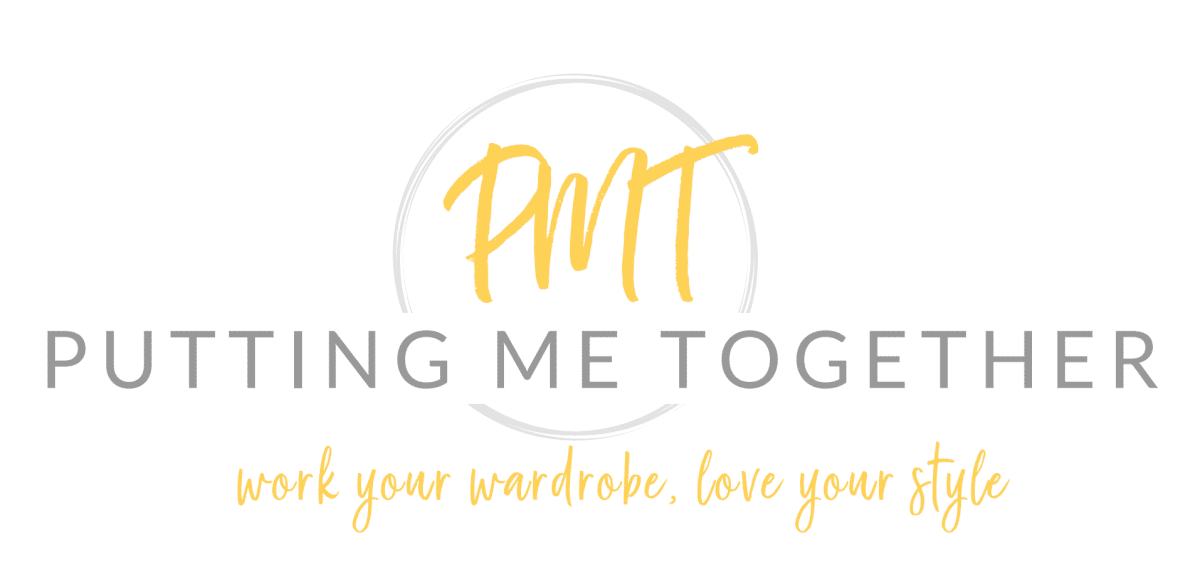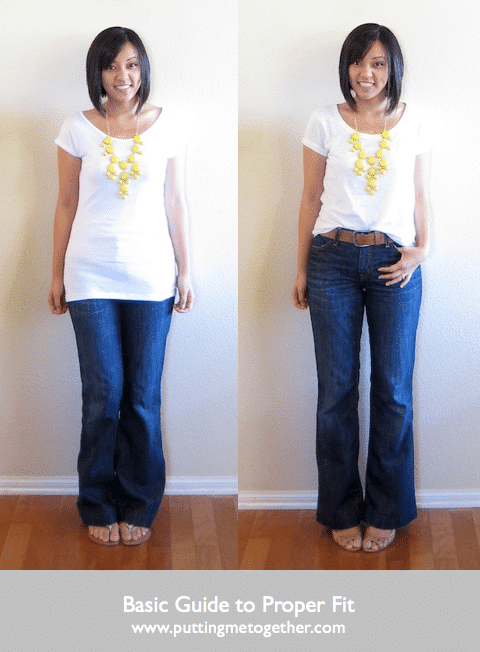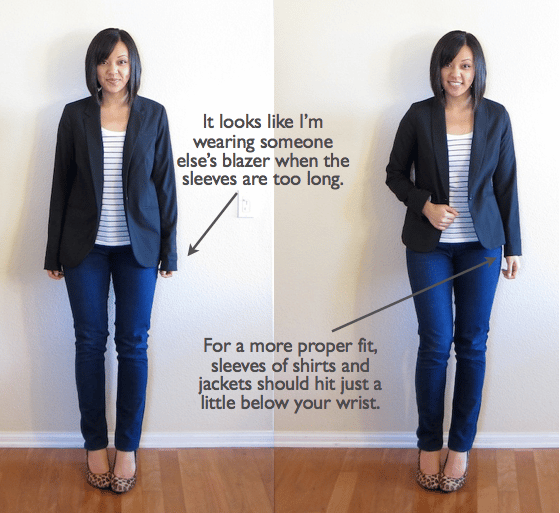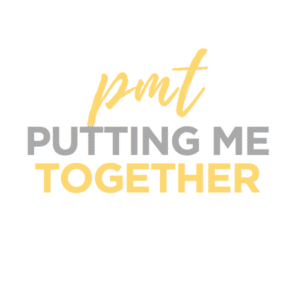We’ve arrived at Part 3 of the
Wardrobe From Scratch series, dipping our toes into the waters of clothing fit. I say we’re “dipping our toes” because this is a Fit 101 type of thing, not by any means an exhaustive guide to fit. If you’re looking for which shapes will flatter different body types, we’ll do that later in this series, but not today. Like the title of the post says,
today is just a basic guide to proper fit!
Why Fit Matters
In the words of Stacy and Clinton, “If you don’t have fit, you don’t have style.” Here’s a great example. I love these pictures of Lauren Conrad and Jennifer Aniston:
When I saw people wearing simple outfits like these, just a pair of jeans and a white tee, I wondered how they managed to look chic and put together while another person wearing jeans and a white tee looked…well…a little frumpy. Why? Is it because Jennifer Aniston has great hair? Are Lauren Conrad and Jennifer Aniston both just so cute that anything looks good on them? True and true, but really, the answer is because what Stacy and Clinton say is true. Proper fit is key to style and looking put together.
I wrote in the Building a Remixable Wardrobe Series that one way I learned to remedy some frump factor was to add an accessory. But sometimes even an accessory won’t pull things together and the outfit will still look sloppy because all the accessories in the world cannot make up for the effect that ill-fitting clothes have on style.

Here’s an example of me trying to recreate the jeans and a white tee look with ill-fitting clothes and then with proper fitting clothes. I even added an accessory to try to make up for the weird fit in the first outfit, but it didn’t help. The first picture looks a little sloppy and a bit awkward, not ideal. The second outfit uses the same components but looks much more put together, all by changing the fit of the garments.Now, rather than striking anxiety in you about your clothes fitting, I hope that this is actually encouraging. Because as Jennifer Aniston and Lauren Conrad illustrate above, you don’t have to be good at accessorizing, wear flashy clothes, or have trendy items to look stylish or to look put together–a couple of well-fitting items can do the trick. Basically, be encouraged because once you get the right pieces you might not have to try so hard to look put together! Sweeeeeet!
Some Notes
As we go into some general guides of proper fit I want to remind us that eventually in this series we’ll get to the types of shapes that will flatter different body types, but not today. Hang tight as we talk about the basics today.
Second, I recognize rules of fit can be bent and broken and you can still look chic. (This is especially true if you are super tall and skinny!) Just take these as a general guide or a basis from which to start if you are lost as to where your clothes should start and end on your body.
Third, the next post in this series will be sort of a part two to this fit guide, talking about alterations and what kinds of garments you can have altered and how. Today’s post will help you to know when/what/how you should get things tailored.
Finally, I’m totally NOT an expert in fit. I’m seriously just regurgitating anything I’ve ever heard Stacy and Clinton say and putting it all in one place (this blog) for yall to reference. Anyone else who actually knows what they’re talking about, feel free to chime in on the comments, answer people’s questions, and add to or correct anything I’ve said here!
Let’s do it!
Tops / Blazers
Shoulders. The seam of the shoulder should more or less match where your real shoulder is. Even for my shirts that have a looser and more flowy fit, the shoulder seams still line up with my shoulders. If the seam goes too far past your shoulder it will awkwardly broaden you shoulders and make you look like you’re swimming in your clothes, which you don’t want. (I wish I had a picture to illustrate it for you, but I’ve basically gotten rid of all of my shirts that don’t fit in the shoulders.)

Hem. I’ve heard Stacy & Clinton say that for most people (read: not super tall people with really long legs) the hem of the shirt should end around mid hip, and not too far past the crotch of your pants. This is to elongate the leg line. One of my friends wore really long tops because she was trying to hide her midsection, but she was actually creating a weird silhouette for herself and accentuating her midsection instead.
I bought the top in the picture on the left years ago, not realizing that it was way too long for me. And even after I realized it was too long I still wore it for a while thinking it looked okay. But now when I look at the difference between that top and a top that hits at the proper part of my hip, I can’t believe I wore the long top. It looks kind of unpolished compared to a shorter one.

Button-fronts should close without gaping. This is true for a button-up top, a cardigan, and a jacket. If the garment gapes when buttoned, no matter what bust size you are, it’s too small. In the next post about tailoring we will talk about altering tops for women with larger busts.
Sleeves. Sleeves should fit just a little past your wrist, or as Stacy and Clinton say, “On the ‘fleshy’ part of your palm/.”
Otherwise, it looks like you are wearing someone else’s clothes. Plus, it doesn’t look very polished when you look like you’re drowning in your clothes.
Pants
No Muffin Tops
Alright, let’s just get it out there. Pants are hard to find, which is why in the next post we’re going to talk about alterations to get your pants to fit right. Honestly you guys, pants are hard to find for almost
everyone. Yes, harder for some than others, but still all around difficult. But that is not any sort of excuse for settling for the
muffin top.
A lot of you might think the muffin top is there because that is
just how your body is, but more often than not it can actually be contained a little by–you guessed it–PROPER FIT. Usually either 1) your waistband is too small and you’re wearing the wrong size, or 2) you need to go for pants with a higher rise. If you are having problems with a muffin top, first try wearing a different size and make sure it is NOT odd numbered. Odd numbered sizes are for juniors with junior type bodies (aka no curves), not womanly figures. If that doesn’t work, try going with a higher rise. Low rises usually sit a few inches below the belly button which does nothing to help contain and control any sort of tummy, in which case it’ll spill out over the jeans and form a muffin top. A higher rise (and the right size) will contain it everything where it should be instead of smooshing things around in odd places. I’m not saying to wear high waisted
mom jeans, but some sort of mid-rise would be worth a shot.
Hem. Hems of pants are a little more involved. There are so many variables with pant hems depending on the cut of the pants and whether or not you’re wearing the pants with heels or flats, etc.
Basically, on one hand they shouldn’t be so long that your pants drag on the ground. Not only does it ruin your pants, but it actually pulls the eye downward and gives the overall appearance of droopiness rather than polished.
On the other hand, we don’t want pants to be too short lest we look like we’re in the middle of an awkward teenage growth spurt.
So, what is the perfect pant length, you ask? Like I said, it’s kind of involved, so instead of me writing it all here,
Already Pretty has a great post on pant lengths that I want to direct you to. I found it really helpful and took into consideration stuff like flats versus heels and bootcuts versus skinnies versus trousers, etc. Fantastic stuff, so check it out!
Put It Together
Well, there you have it–the basics of fit. I think there’s a couple that I left out, but this should be enough to start you off. Hopefully it wasn’t too overwhelming and actually a little helpful.
I’d really, really encourage you to do the work of finding clothes that fit well or altering them so that they fit. Sometimes you might think the fit is “not that bad” but when you compare it to what it could be if the pieces actually fit you, I think it’s definitely worth making sure your clothes fit.
The first outfit may not look that bad, but I definitely don’t think it says polished, like the second one does. And all that happened was making sure the clothes fit right. Not only does proper fit make the overall outfit more polished, it is also more flattering! So why would you settle for “not that bad” when you can easily look more pulled together just by making sure your clothes fit well? 🙂
Remember, the next post in this series is on alterations!
**
For all 6 parts of the Wardrobe From Scratch Series, click HERE.












